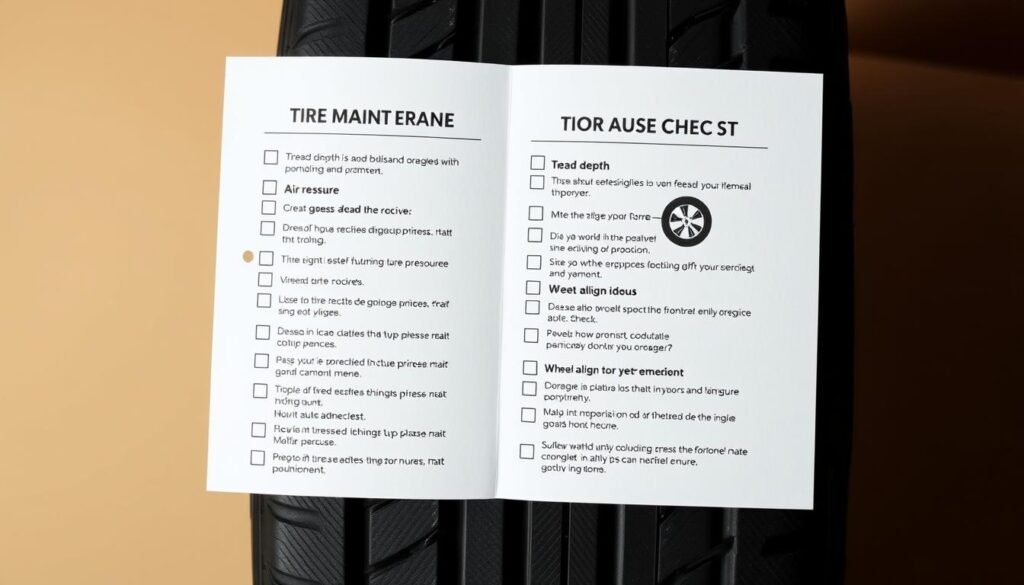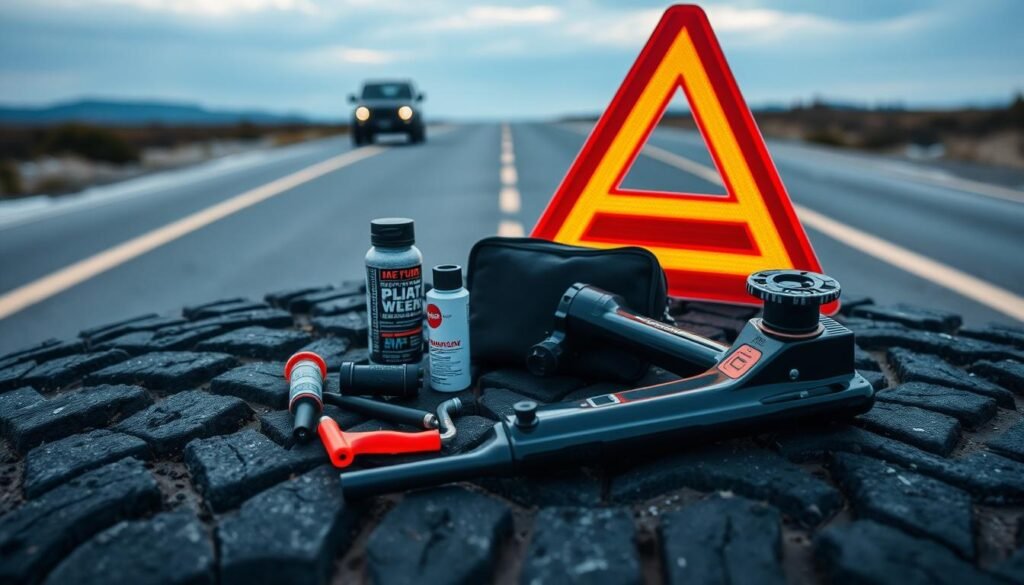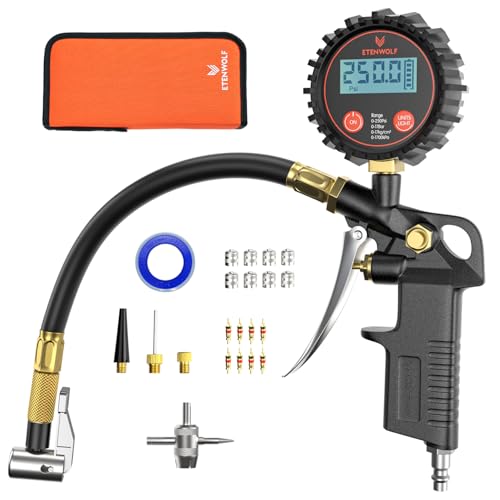When I plan my next road trip, road trip safety is my main concern. Often, people forget about tire care. Not taking care of tire maintenance can cause big safety problems on the road.
Good tires are key to a safe and fun trip. In this article, I’ll give you important tips for getting your tires ready for your next adventure. We’ll focus on tire care and how it helps keep you safe on the road.
Key Takeaways
- Check tire pressure regularly for optimal tire maintenance
- Inspect tires for signs of wear and damage
- Ensure proper tread depth for better traction
- Don’t forget to check the spare tire
- Rotate tires for even wear and longevity
Why Tire Maintenance Is Critical for Road Trip Safety
Before I hit the road, I always check my tires. Their condition is key to my safety. Tire maintenance is vital for a safe journey, affecting my vehicle’s performance and safety.
The Consequences of Neglecting Tire Care
Ignoring tire care can cause problems. It can lead to less traction, a higher risk of tire blowouts, and poor vehicle handling. Poor tire maintenance can result in dangerous situations on the road, potentially leading to accidents. Also, worn-out tires can make your car use more fuel, costing you more money.
How Proper Tire Maintenance Enhances Your Road Trip Experience
Good tire maintenance means safety and a better trip. Well-maintained tires improve vehicle handling and braking performance, making the journey more enjoyable. They also help save fuel, saving you time and money.
By focusing on tire maintenance, I can drive with confidence. I know my vehicle is ready for the road’s challenges.
Essential Tools for Tire Inspection and Maintenance
Having the right tools for tire care is key for a great road trip. Proper tire maintenance keeps you safe and boosts your vehicle’s performance.
Must-Have Tools for DIY Tire Checks
You’ll need a few must-have tools for a detailed tire check. A tire pressure gauge is vital for checking pressure. A tread depth gauge measures the tread depth. A tire inspection light helps spot damage on the tire’s surface.
Optional Equipment That Makes Tire Maintenance Easier
Some optional equipment can simplify tire maintenance. A tire inflator is useful for quick pressure adjustments. A tire repair kit fixes small punctures. These tools can prepare you for any tire issues on your trip.
Checking Tire Pressure: The Foundation of Tire Health
Correct tire pressure is key for tire health, affecting safety and performance. Keeping the right pressure is vital for your tires’ life and your vehicle’s safety.
Finding Your Vehicle’s Recommended Tire Pressure
The recommended tire pressure is on the tire information placard in your driver’s side doorjamb or in your owner’s manual. It’s important to follow these guidelines for the best tire performance and safety.
Step-by-Step Guide to Measuring Tire Pressure
To measure tire pressure, you need a tire pressure gauge. Remove the valve cap, press the gauge onto the valve stem, and read the pressure. The gauge shows the pressure in pounds per square inch (PSI).
Morning vs. Afternoon Pressure Readings
It’s best to check tire pressure when the tires are cold, usually in the morning. Driving warms up the tires, which can give a false reading.
Adjusting for Loaded Vehicle Weight
If you’re carrying a heavy load, you might need to adjust your tire pressure. Check your owner’s manual for guidance.
When and How Often to Check Pressure During Your Trip
Check your tire pressure at least once a month and before long trips. During your trip, check pressure every few days, especially if you’re carrying a heavy load or driving in extreme temperatures.
By following these guidelines, you can keep your tires healthy and make your road trip safe and fun.
Inspecting Tire Tread Depth for Safe Travels
Safe travels start with well-maintained tires, especially the tread depth. Keeping your vehicle’s tires in top shape is key for a safe and fun road trip. Checking the tire tread depth is a crucial part of tire care.
Understanding Minimum Safe Tread Depths
In the U.S., tires are legally worn out at 2/32″ (1.6 mm) tread depth. But for the best safety, especially in bad weather, replace tires at 4/32″ (3.2 mm) or more.
The Penny Test and Other Measurement Methods
There are many ways to check tire tread depth, like the penny test. To do the penny test, put a penny into the tire groove with Lincoln’s head down. If you see the top of his head, your tread is too low. For exact measurements, use a tread depth gauge.
Using a Tread Depth Gauge Correctly
A tread depth gauge gives you precise tread depth readings. Place the gauge into the tire groove and read it. Check different spots around the tire for an accurate average.
Visual Indicators of Tread Wear
Many tires have tread wear indicators (TWI). These are rubber bars across the tread. When they’re at the same level as your tread, it’s time for new tires.
Signs It’s Time to Replace Your Tires Before Your Trip
Signs of wear like uneven tread, sidewall cracks, or tires older than 6 years mean it’s time for new ones. Regular checks can spot these problems early.
| Tread Depth (in/32nds) | Safety Recommendation |
|---|---|
| 2/32″ | Legally worn out; consider replacement. |
| 4/32″ | Recommended for replacement, especially for wet conditions. |
| 6/32″ | Good tread depth; safe for most driving conditions. |
By checking your tire tread depth and knowing wear signs, you can make your journey safer. Regular tire care is a simple way to keep your vehicle safe and running well.
Examining Tire Sidewalls for Damage and Defects
Before you hit the road, make sure to check your tires. Look closely at the sidewalls, the area between the tread and the bead. This part is key to your safety and how well your vehicle performs.
Common Sidewall Issues to Watch For
Tire sidewalls can get damaged in many ways. You might see bulges, blisters, cracks, or cuts. These problems can come from road hazards, not enough air, or just getting old.
Bulges and Blisters: What They Mean
Bulges and blisters show weak spots in the sidewall. They might be from a bad tire or damage from the road. If you see these, your tire could fail badly.
Cracks and Cuts: Assessing Severity
Cracks and cuts can happen from hitting road debris. It’s important to check how bad they are. This will tell you if you need a new tire.
When Sidewall Damage Requires Immediate Attention
Big damage like large cracks, bulges, or cuts needs a quick check by a pro. Sidewall damage can make a tire unsafe. Replacing it before you go is safest.
Tips Your Car Tire Maintenance Before a Trip: A Complete Checklist
Before my next road trip, I always check my tires. It’s important for safety and fun. Here’s how to get your tires ready for the trip.
One Week Before: Initial Assessment and Planning
First, check your tire’s condition. Look at the tread depth and for uneven wear. Also, check the sidewalls for damage.
A tire expert once said, “The condition of your tires can make or break your road trip experience.” Note any problems and plan. If unsure, get a professional’s opinion.

Three Days Before: Adjustments and Professional Services
Three days before, make any needed adjustments. Check and adjust tire pressure to the right levels. You can find this in your owner’s manual or on the driver’s side doorjamb.
Scheduling Professional Inspections If Needed
If you found issues, schedule a professional inspection. A mechanic can assess and fix problems. Remember, “An ounce of prevention is worth a pound of cure.”
DIY Adjustments You Can Make Safely
For small problems, you can fix them yourself. This might include rotating tires or simple repairs. Always follow safety guidelines and check your manual.
Day Before Departure: Final Checks and Documentation
The day before, do a final tire check. Make sure pressure is right and there’s no damage. Also, have your vehicle’s documents ready.
By following this checklist, you’ll have a safe and fun trip. Experts say, “
A well-maintained vehicle is key to a stress-free journey.
” So, take the time to check your tires, and you’ll be ready to hit the road with confidence.
Tire Rotation and Balancing: Should You Do It Before Your Road Trip?
I’ve learned that regular tire rotation and balancing can extend the life of my tires and enhance my vehicle’s overall handling. As I prepare for my next road trip, I consider whether these services are necessary for a smooth and safe journey.
Tire rotation involves moving the tires from one position to another to ensure even tread wear. This process can help extend the life of the tires and improve the vehicle’s performance. On the other hand, tire balancing ensures that the tires rotate smoothly, reducing vibrations that can cause discomfort during long drives.
Signs Your Tires Need Rotation or Balancing
There are several signs that indicate my tires need rotation or balancing. These include:
- Uneven wear patterns on the tires
- Vibrations while driving
- Handling issues, such as pulling to one side
Uneven Wear Patterns to Look For
Uneven wear can manifest in different ways, such as:
- More wear on the center of the tire than on the edges, or vice versa
- Uneven wear between the front and rear tires
- Feathering or cupping on the tire surface
Vibrations and Handling Issues
If my vehicle vibrates excessively or pulls to one side while driving, it may be a sign that the tires are out of balance or need rotation. I should have these issues checked by a professional to determine the best course of action.
Timing These Services for Maximum Benefit and Comfort
The timing of tire rotation and balancing depends on various factors, including the vehicle’s manufacturer recommendations and my driving habits. Generally, tire rotation is recommended every 6,000 to 8,000 miles, while balancing may be needed more frequently if I notice vibrations or uneven wear.
By considering tire rotation and balancing before my road trip, I can ensure a smoother, safer journey and potentially extend the life of my tires.
Preparing for Tire Emergencies on the Road
When I plan my next road trip, I know how vital it is to be ready for tire emergencies. These situations can be stressful and even dangerous if not managed correctly. Having the right tools and knowledge can greatly help.
Essential Items for Your Tire Emergency Kit
A good tire emergency kit is key for dealing with tire issues. It should have a spare tire, tire iron, lug wrench, car jack, and tire sealant. Don’t forget a flashlight, gloves, and a first-aid kit either.
- Spare tire
- Tire iron and lug wrench
- Car jack
- Tire sealant
- Flashlight
- Gloves
- First-aid kit
Basic Tire Change Procedure Refresher
Knowing how to change a tire is a must for every driver. Here’s a quick guide on the basic steps.
Finding a Safe Location to Change a Tire
After a tire blowout, move to a safe spot as quickly as you can. Look for a flat, stable area that’s away from traffic.
Proper Jack Placement for Your Vehicle
Where you place the jack is very important for a safe tire change. Check your vehicle’s manual for the right jacking points.

When to Call for Professional Roadside Assistance
If you’re not sure about changing a tire or if it’s too hard, call for professional roadside help. Many auto insurance and roadside services are available 24/7.
| Situation | Action |
|---|---|
| Tire blowout on a busy highway | Call for roadside assistance |
| Flat tire in a safe location | Change the tire yourself or call for assistance |
| Uncertain about changing a tire | Call for roadside assistance |
Special Considerations for Different Road Trip Terrains
Whether you’re heading to the mountains or driving through the desert, your tires need special care. Different terrains pose unique challenges for tire care. Drivers must be proactive in their maintenance approach.
Mountain Driving Tire Preparations
Driving in mountains requires careful tire preparation for safety. The high elevation and steep grades demand more from your tires.
Adjusting Pressure for Elevation Changes
As you go up to higher elevations, the air pressure in your tires goes down. It’s important to check and adjust your tire pressure as recommended by the manufacturer for the elevation change.
Traction Requirements for Steep Grades
Steep mountain roads need tires with good traction to keep control. Make sure your tires have enough tread depth. If you often drive on steep roads, consider tires with a more aggressive tread pattern.
Desert and Hot Weather Tire Care
Driving in desert or hot weather needs special tire care. High temperatures can damage your tires. So, it’s key to check tire pressure often as it may rise with the temperature.
Also, the hot and dry conditions can make your tires wear out faster. So, it’s important to keep an eye on your tread depth.
Winter and Cold Weather Tire Requirements
In cold weather, the right tires are crucial. If you’ll be driving in snowy or icy conditions, consider using winter tires. They offer better traction and control on slippery roads.
Make sure your vehicle’s tires are right for the cold weather you’ll face on your trip.
Conclusion: Drive with Confidence Through Proper Tire Care
As you get ready for your next road trip, remember that proper tire care is key. It ensures a safe and fun journey. By following the tips in this article, you can be sure your tires are ready for the road.
Regular tire checks do more than just keep you safe on trips. They also make your car run better. Checking pressure, looking at tread depth, and checking for damage on the sidewalls helps catch problems early.
With the right tire care, your road trip will be stress-free. You can explore new places without worry. Your tires are the base of a safe trip, no matter where you go. By taking care of your tires, you can enjoy time with loved ones, not worry about your car.
FAQ
How often should I check my tire pressure before a road trip?
Check your tire pressure at least once a week. Do it especially before a long road trip. This ensures it’s at the right level.
What is the recommended tire pressure for my vehicle?
The recommended tire pressure is on the tire information placard. It’s on the driver’s side doorjamb or in your owner’s manual.
How do I know if my tires need to be replaced?
If your tires are down to the minimum safe tread depth, it’s time to replace them. Look for signs of uneven wear, cracking, or damage.
What is the penny test for checking tire tread depth?
For the penny test, insert a penny into the tire groove with Lincoln’s head down. If you see the top of Lincoln’s head, your tread is too low. It’s time for new tires.
Can I rotate my tires myself, or should I take it to a professional?
You can rotate your tires yourself. But, if you’re unsure about the rotation pattern or see uneven wear, take it to a professional.
What should I include in my tire emergency kit?
Your tire emergency kit should have a spare tire, tire-changing equipment, and a tire pressure gauge. Include other essentials for a tire emergency.
How do I know if I need to balance my tires?
If you notice vibrations or uneven wear, your tires might need balancing.
Are there any special tire considerations for driving in extreme weather conditions?
Yes, extreme weather like snow, ice, or heat requires special tire considerations. Use snow tires or adjust your tire pressure as needed.
Can I drive on a tire with sidewall damage?
Driving on a tire with sidewall damage is not safe. It can cause a blowout. Have it checked by a professional and replace it if needed.
How often should I check my tire tread depth during a road trip?
Check your tire tread depth regularly during a long road trip. This ensures your tires are safe and effective.



